
Buffalo City Hall is the seat for municipal government in the City of Buffalo, New York. Located at 65 Niagara Square, the 32-story Art Deco building was completed in 1931 by Dietel, Wade & Jones.

The Guaranty Building, formerly called the Prudential Building, is an early skyscraper in Buffalo, New York. It was designed by Louis Sullivan and Dankmar Adler and completed in 1896. The building has been declared a National Historic Landmark.

The Carling, formerly known as the Carling Hotel and Hotel Roosevelt, is a historic building in Jacksonville, Florida, United States built in 1925. It is located at 31 West Adams Street in Downtown Jacksonville. As its former names indicates it was originally a hotel, and was used for that purpose until 1964; it currently serves as a residential building.
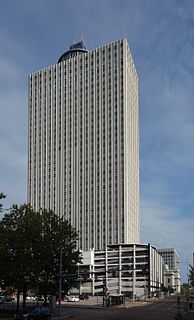
100 North Main is the tallest building in Memphis, Tennessee. At 430 feet, (131m) it has 37 floors and stands bordering Adams Avenue, North Second Street, and North Main. The building is currently totally vacant and closed to public entry. Plans for renovation to convert the building to hotel and apartments have repeatedly failed. The building stands abandoned and fenced off as of May 2016. The building has been condemned by Shelby County Environmental Court since late 2015 when it was discovered that chunks of concrete were falling from the building's exterior walls, as well as the elevators being inoperable and the fire safety systems not being up to code or functional. It was listed on the National Register of Historic Places in 2015.
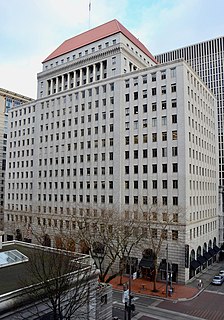
The Public Service Building is a historic 67.06 m (220.0 ft), 15-story office building in downtown Portland, Oregon, United States. The building and its attached parking garage have been listed on the National Register of Historic Places as the Public Service Building and Garage since 1996. It was built to house the offices of the Portland Gas and Coke Company and the Pacific Power and Light Company. The building's name reflects the fact that these utilities were "public services". A space in the Public Service Building fronting the corner of Salmon and Sixth streets became the first Niketown store.
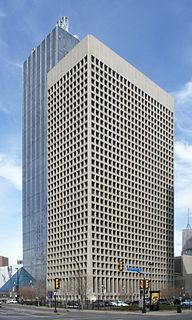
One Main Place is a mixed-use skyscraper hotel and office building at 1201 Main Street in Dallas, Texas. The building rises 445 feet. It contains 33 above-ground floors, and was completed in 1968. One Main Place currently stands as the 27th-tallest building in the city. The architectural firm who designed the building was Skidmore, Owings & Merrill, who also designed the Willis Tower and John Hancock Center in Chicago and the Burj Khalifa in Dubai. Gordon Bunshaft was the lead designer of One Main Place and a few of his notable buildings include Lever House in New York, the Beinecke Rare Book and Manuscript Library at Yale University, and the Hirshhorn Museum and Sculpture Garden in Washington, D.C. The building was listed on the National Register of Historic Places in 2015.

James Addison Johnson was an American architect known for his design of various architectural landmarks in Buffalo, New York, and his use of decorative work that many consider a foreshadowing of art deco design.
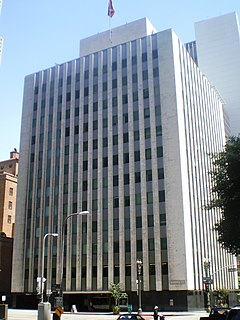
The Superior Oil Company Building, currently The Standard Downtown LA and previously the Bank of California Building, is a 12-story marble-clad highrise building located at 550 S Flower St in Downtown Los Angeles. The office building was refurbished as a hotel in 2002.

The Harmonie Centre, also known as the Breitmeyer–Tobin Building, is an eight-story commercial building located at 1308 Broadway Street in Downtown Detroit. It is part of the Broadway Avenue Historic District. It is also known as the Tobin Building. The building was listed on the National Register of Historic Places in 1980. The east necklace of downtown links Grand Circus and the stadium area to Greektown along Broadway. The east necklace contains a sub-district sometimes called the Harmonie Park District, which has taken on the renowned legacy of Detroit's music from the 1930s through the 1950s and into the present.

The Arctic Club Building is a nine-story hotel in Seattle, Washington located at the Northeast corner of Third Avenue and Cherry Street. Built in 1916 for the Arctic Club, a social group established by wealthy individuals who experienced Alaska's gold rush, it was occupied by them from construction until the club's dissolution in 1971. It is entirely faced with cream white terra cotta with submarine blue and orange-brown accents. It has terra cotta walrus-heads lining the third floor of the building and was also adorned with a polar bear. It is one of the finest examples of multi-colored matte glaze terra cotta work in the city. Recently restored, the building has been adapted for use as a luxury hotel, Arctic Club Seattle. A roof garden used by the social club was replaced with a penthouse office suite.

Louis Singleton Curtiss was a Canadian-born American architect. Notable as a pioneer of the curtain wall design, he was once described as "the Frank Lloyd Wright of Kansas City". In his career, he designed more than 200 buildings, though not all were realized. There are approximately 30 examples of his work still extant in Kansas City, Missouri where Curtiss spent his career, including his best known design, the Boley Clothing Company Building. Other notable works can be found throughout the American midwest.

The Architecture of Buffalo, New York, particularly the buildings constructed between the American Civil War and the Great Depression, is said to have created a new, distinctly American form of architecture and to have influenced design throughout the world.
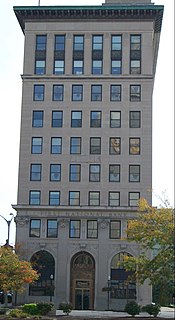
The First National Bank Building is an historic building located in downtown Davenport, Iowa, United States. It was individually listed on the National Register of Historic Places in 1983. In 2020 it was included as a contributing property in the Davenport Downtown Commercial Historic District. The building is now known as the US Bank Building, its main tenant.

The Putnam-Parker Block, also known as City Square, are historic structures located in downtown Davenport, Iowa, United States. The property is three buildings that take up the south half of block 43 in what is known as LeClaire's First Addition. The main façade of the structures face south along West Second Street. They were listed on the National Register of Historic Places in 2011. In 2020 it was included as a contributing property in the Davenport Downtown Commercial Historic District. The former Putnam Building now houses a Marriott Autograph Collection hotel named The Current Iowa.

The Hamilton Hotel, formerly known as the Hamilton Crowne Plaza, is an AAA 4-diamond luxury hotel in downtown Washington, D.C., United States, located at 1001 14th Street, N.W., just to the north of Franklin Square. In September 2017, the hotel became independent from the Crowne Plaza hotel chain.

Acorn Corner, originally known as the Franklin Hotel or Hotel Franklin, is a six-story historic building in Kent, Ohio, United States, listed on the National Register of Historic Places since January 2013. Construction started in 1919 and the hotel opened in September 1920. The hotel was also known as the Hotel Kent and later the Hotel Kent-Ellis. Locally it is often referred to as the "old Kent hotel", "Kent Hotel", or the "old hotel". The building functioned as a hotel until the early 1970s when it was converted for use as student housing. The upper four floors were condemned in 1979, though the bottom floors housed a number of small businesses until 2000.
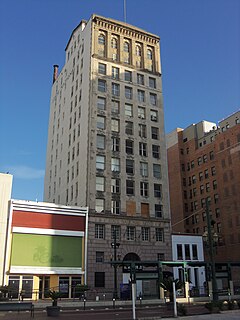
The State National Bank Building is a high-rise office building located at 412 Main Street in downtown Houston, Texas. Designed by architect Alfred Charles Finn, the building was built in 1923 in the Spanish colonial style. It was listed on the National Register of Historic Places on August 11, 1982.
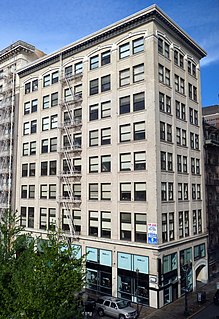
The Woodlark Building is a historic commercial building in downtown Portland, Oregon, United States that is listed on the National Register of Historic Places. The nine-story building was designed by Doyle, Patterson & Beach, and constructed in 1911–12. It has been described as "one of Portland's earliest commercial skyscrapers". From its completion until 1924, it was the headquarters of two jointly owned and very similarly named pharmaceutical companies based in Portland, the retail Woodard, Clarke & Company, and the wholesale Clarke-Woodward Company. It was converted into an office building in 1924. The retail space on the ground floor, mezzanine and basement has held a variety of businesses, in succession over the building's history, among the longest-lasting ones being a drugstore (1912–1927), a Sherman Clay piano and music store (1930–1974), and an independent shoe store (2000–2016).

The Chez Ami, known as the Chez Ami Supper Club, was located at 311 Delaware Avenue in Buffalo, NY and first opened its door in 1934. It is considered one of the first supper clubs in the nation and had the first rotating bar in the United States. The club was owned and operated by Philip Amigone until his death in 1965. It was subsequently torn down in 1974.

The Carnegie Building is a historic building located at 141 Carnegie Way in downtown Atlanta, Georgia, United States. Built in 1925 as the Wynne-Claughton Building, the 12-story building was designed by architect G. Lloyd Preacher. It was designated an Atlanta Historic Building in 1990 and was added to the National Register of Historic Places in 2012.
























